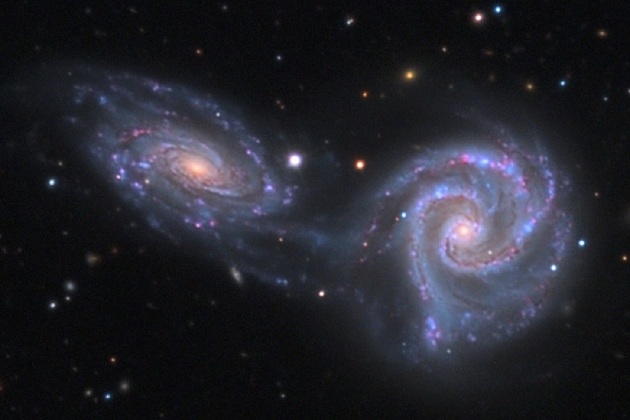By Annelies Rhemrev
November 21, 2012
Arp 271, a pair of interacting galaxies in Virgo
Image Credit & Copyright: Adam Block/Mount Lemmon SkyCenter/University of Arizona (http://www.caelumobservatory.com/index.html)
Click here for a larger image.
Arp 271 is a pair of interacting spiral galaxies: NGC 5426 (the more oblique galaxy at left) and NGC 5427 (the nearly face-on spiral galaxy at right). Together they are about 130,000 light-years across and located some 90 million light-years away towards the constellation of Virgo.
The galaxies are in the throes of a slow but disturbing interaction, that began likely a several million years ago. These twin galaxies — which have similar sizes, masses, structures, and shapes with expansive arms and a compact core – appear undisturbed. But the mutual pull of gravity has already begun to alter and distort their visible features.
The gravity between the interacting galaxies has begun to pull some of the outer stars towards the center creating a bridge of stars. This intergalactic bridge acts like a feeding tube, allowing the twins to share gas and dust with one other across the 60,000 light years of space separating them.
Colliding gases caused by the interaction also triggered bursts of star formation in each galaxy. Star-forming, or HII, regions appear as hot pink knots that trace out the spiral patterns in each galaxy. The giant ones in NGC 5426 are more abundant on the side of the galaxy closest to NGC 5427. Starburst activity can also be seen in the galaxy’s connecting bridge.
Likewise, the giant HII regions in NGC 5427’s disk are forming at a high rate and are plentiful. One giant star-forming region at the tip of NGC 5427’s western spiral arm, looks especially large and disturbed, as does the arm itself, which is unusually straight, as if strong tidal forces have broken the arm in two, causing it to bleed starlight.
It is not certain that the interaction between the two galaxies of Arp 271 will end in a collision and ultimately a merging of the two galaxies, although the galaxies have already been affected. This dramatic dance will last for tens of millions of years, creating new stars as a result of the mutual gravitational attraction between the galaxies.
Once thought to be unusual and rare, gravitational interactions between galaxies are now known to be quite common (especially in densely populated galaxy clusters) and are considered to play an important role in galaxy evolution. Most galaxies have probably had at least one major, if not many minor, interactions with other galaxies since the advent of the Big Bang.
Quite possibly, our own Milky Way will undergo a similar collision in about five billion years with the neighbouring Andromeda galaxy, which is now located about 2.6 million light-years away from the Milky Way.
See more images on Anne’s Astronomy News



